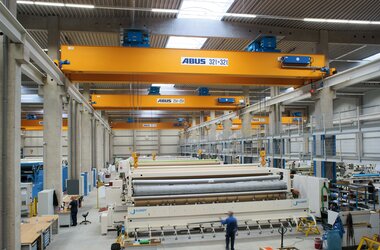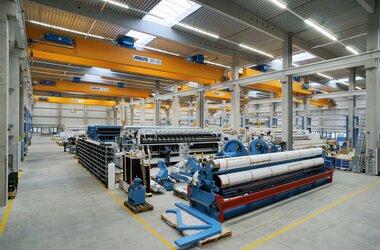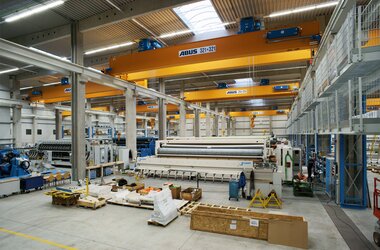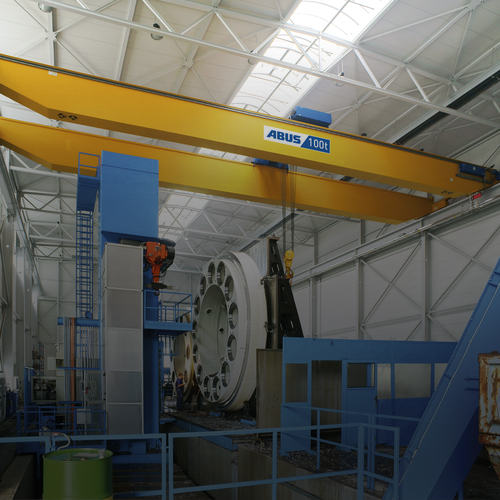ABUS EOT cranes for a German producer of slicing machines and winders for foils
Foil – an ultra-thin material with a wide range of applications
Normally, if you think of foil you think of a very thin sheet of metal or a thin layer of plastic material. Foil was first known to be made from gold leaf laboriously hammered by hand and was used to hold gemstones. Over time foil became synonymous with very thin material with a large surface that is almost tear-proof. Foils have many uses not only in daily life but also in technical and even medical applications: packaging foils protect food products during transport, sunscreens and solar films protect against light and heat, and antimicrobial foils are used for medical purposes.
Kampf cutting and winding technology – innovation married to tradition
ABUS has customers in many far-flung places but some also just down the road from headquarters. One such is the company Kampf, meaning “fight” in English. The company Kampf Schneid- und Wickeltechnik GmbH & Co.KG (www.kampf.de) at Wiehl, a town not far away from Cologne in the west of Germany, has been producing slitters and winders for foil converting and film processing for more than 90 years. The company was established in 1920 when Erwin Kampf started a company for the production of slitter winders and winders for the paper processing industries. Patents taken out in the 1960ies for so-called biaxial stretching lines for films are testimony to the great innovative energy of this company shown early on. Kampf pioneered this particular machinery segment in the following years and in 1969 the world’s first station machine for foils of up to 5 metres working width was delivered. Until this day it is innovation in product development in conjunction with international customers that is one of the key factors in the success of Kampf. Kampf even built a technology centre, the “Technikum”, for research and development. During the past 15 years Kampf has grown into a global player by establishing companies in India and China and by handling major international projects. Kampf now export over 80% of their products. More than 500 staff are employed in the German part of Kampf’s business and they also have a worldwide sales and service net in place. However, the hub of the activities remains firmly at their headquarters in Wiehl-Mühlen which saw the festive opening of four new assembly halls in July 2013 boasting a total surface of 6,400 square metres. These new halls actually double the assembly area. A new office building as well as training centre are also scheduled to be built in 2013 to complete the site and to make it fit for the future.
Heavyweights for delicate end products – ABUS cranes at work
The foils to be processed are only a few micro metres thick and thus pretty weightless, however, the cutting and winding machines are another matter: they are true heavyweights weighing up to 64 tonnes. The architect in charge explained that the dimensions and the weights of these machines could easily reach those of single-family homes when the new halls were officially opened and the guests were duly impressed. The company Kampf has been relying on tried and tested ABUS technology for many years in order to transport machinery elements in the assembly areas and also to load the finished machines for shipping. Work station solutions consist of jib cranes, suspended rail systems, and single girder EOT cranes with low load capacities. However, more often than not the weights of the elements to be transported are quite high thus requiring the use of double girder EOT cranes. For this reason the four new assembly halls were equipped with a total of 11 double girder EOT cranes with load capacities ranging from 32 to 64 tonnes. All crane systems feature double-rail trolleys as hoist systems. This makes it possible to safely transport big machinery with widely separated load connection points. In addition, the crane and hoist travel drives feature frequency converters for precise and delicate handling of the machines especially when it comes to loading them for shipment. The cranes are controlled by ABUS radio remote controls. The crane users are thus able to operate the cranes from safe positions and they are continually informed on the loads currently suspended from the hooks by the load displays integrated into the radio remote controls.











